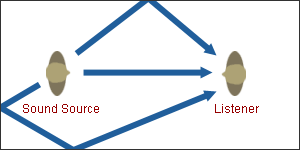Here’s another cool link for my budget conscious musician/composer friends:
It’s called Freeverb3 by Teru Kamogashira, and you can find it here:
http://freeverb3.sourceforge.net/
And what is Reverb, you ask? Here’s a short explanation from MediaCollege.com:
“Reverberation, or reverb for short, refers to the way sound waves reflect off various surfaces before reaching the listener’s ear.
 The example on the right shows one person (the sound source) speaking to another person in a small room. Although the sound is projected most strongly toward the listener, sound waves also project in other directions and bounce off the walls before reaching the listener. Sound waves can bounce backwards and forwards many times before they die out.
The example on the right shows one person (the sound source) speaking to another person in a small room. Although the sound is projected most strongly toward the listener, sound waves also project in other directions and bounce off the walls before reaching the listener. Sound waves can bounce backwards and forwards many times before they die out.
When sound waves reflect off walls, two things happen:
- They take longer to reach the listener.
- They lose energy (get quieter) with every bounce.
The listener hears the initial sound directly from the source followed by the reflected waves. The reflections are essentially a series of very fast echoes, although to be accurate, the term “echo” usually means a distinct and separate delayed sound. The echoes in reverberation are merged together so that the listener interprets reverb as a single effect.
In most rooms the reflected waves will scatter and be absorbed very quickly. People are seldom consciously aware of reverb, but subconsciously we all know the difference between “inside sound” and “outside sound”. Outside locations, of course, have no walls and virtually no reverb unless you happen to be close to reflective surfaces.
Some rooms result in more reverb than others. The obvious example is a hall with large, smooth reflective walls. When the hall is empty, reverb is most pronounced. When the hall is full of people, they absorb a lot of sound waves so reverb is reduced.”